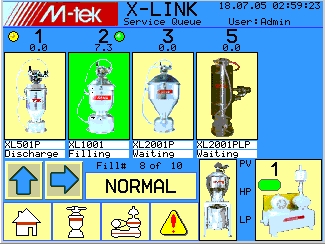
Ability to automatically determine the optimal load time through the specially developed “learning process”
Our test results indicate that INTELECS™ BATCH implementation may result in 10-50% of throughput increase on batch blenders with pinch valve or slide gate dosing mechanisms without any changes to their mechanical designs. INTELECS™ BATCH system has been tested with a wide range of materials on blenders that use different physical principles of material dispensing. The control system consistently achieves superior throughput and accuracy working with rubber pinch valves, steel slide gates or vibrating feeders as actuators.
User-based security system
The VLC system has a user-based security system. The standard access levels include Operator, Supervisor and Administrator. Every user has a unique password required for any parameter or configuration change in the system. Operators are allowed to change the basic operating parameters such as load time, discharge time and material percent for ratio loaders. Supervisors and Administrators can change loader types in the system configuration and re-assign loaders from one pump to another. Administrators also can edit user lists and gain access to the VLC system general parameters area.
.bmp)
Ability to calculate and report material usage
The volume of every loader is known and the optimization “learning process” described earlier makes sure that every loader is completely filled with material during every loading cycle. This creates conditions for accurate estimate of the amount of material going through every loader. The accuracy of such estimate may vary from case to case.
Ability to calculate and report loader throughput
The calculation of material flow is also possible because of the full optimization of the loading process. Knowing the amount of material in the loader and the time period during which the material is consumed, the VLC system can estimate the throughput of the process fed by the loader. Such estimate is accurate enough to provide an operator with an additional indicator of what the real process parameters are.
Recording of vital statistical parameters such as hours of operation for pumps and loaders
The VLC system keeps extensive statistical records about plant operations. This includes hours of operation for pumps, material throughput for each loader, waiting time, number of calls for material, etc. The optional software module allows the VLC system to record all system historical information on the Flash Drive for further periodical storage in a relational database running on another computer.
Extensive alarm and warning system
The alarm system of VLC registers communication errors, low- and high-pressure conditions and other abnormal situations. All important alarms trigger Alarm Light and Sound that can be silenced upon an acknowledgement of the alarm by an operator.
"No Material Flow" and "Blocked Line" detection
The VLC system has a built-in diagnostics that allows detecting abnormal system conditions such as broken or blocked vacuum lines and "no material flow" event. The diagnostic system is based on the pressure monitoring and can be tuned for any type of equipment and/or combination of process conditions.
Wireless access to the VLC control system using built-in web server
Every VLC central controller has a network card and a built-in web server that provides read / write access to the system parameters via standard HTTP protocol. This means that each VLC controller can serve web pages with real-time system information and accept commands sent by a client computer running a standard web browser. If VLC controller is connected to a wireless router, a wireless client computer such as PDA, Tablet PC or even a notebook can be used to update system parameters, make changes or monitor the VLC system. The wireless network access is password protected and granted only to the users registered in the VLC controller web server configuration.
Smart sequencing of loaders based on prioritized FIFO principle
The VLC vacuum loading system is designed to optimally process all requests for material from multiple loaders sharing a single pump. Theoretically speaking, this is the case described by the Theory of Mass Service that provides a number of useful algorithms. When it comes to processing loaders requests, not all of them are equally urgent. A loader may deliver material to a machine running at high speed or may be used to periodically refill a large storage bin. In the first case the request should be immediately fulfilled. In the second case there may be a large amount of material in the storage bin and the delivery of additional material can be delayed. The VLC system builds prioritized FIFO (First-In-First-Out) sequence placing loaders in the service queue based on the time of the request and on the priority of the request. The priority of the request is determined according to the calculated loader throughput and the estimated material storage capacity under the loader. The sequence of loaders in the service queue can be automatically changed by the VLC system based on the most recent evaluation of changing conditions. Knowing the load time of each loader, the VLC system can precisely determine the waiting time for the currently built service queue. If the priority calculation for a newly posted request tells the system that this loader should be placed in the middle of the existing service queue, the VLC system determines the necessary position for the loader and re-arranges the service queue accordingly. The VLC system can independently and simultaneously process a virtually unlimited number of Service Queues.